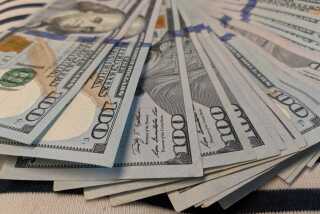Yen and Yang : This Time, Stronger Dollar Benefits Both Japan and U.S.
- Share via
TOKYO — It once seemed so simple. A bit more than a decade ago, a weak yen made high-quality Japanese exports cheap, which led to such tough competition for U.S. firms that industries from autos to steel to semiconductors suffered losses and layoffs. And it sent the U.S. trade deficit soaring.
But the reverse--a weaker dollar against the yen, such as seen from 1993 through last year--helps the United States export more and create more jobs, which is what happened as the yen leaped to a post-World War II peak of 79.75 yen to the dollar in April 1995. And the U.S. trade deficit started to shrink.
Now the yen is weaker again, trading Thursday in New York at 108.46 yen to the dollar, and many giants of U.S. industry are predictably unhappy about it.
“The recent dramatic weakening of the yen against the dollar is most worrisome,” Donald V. Fites, chairman of Caterpillar Inc. and also head of the U.S. Business Council, said here last week. “The yen at 110 to the dollar has the potential to erase and reverse the recent beginning of the improvement in our bilateral trade balance.”
But such complaints ring hollow here. Just a few years ago, an exchange rate of 110 yen to the dollar would have been considered highly advantageous for U.S. firms, helping them to compete with Japanese products. Besides, Americans have been boasting that their improved competitiveness was due partly to better productivity, quality and corporate savvy.
“From the point of view of America and its trade position, it’s certainly somewhat disappointing to hear American industry whining about losing competitiveness if the yen moves in the 110-to-115 range,” said Jesper Koll, head of economic research at J.P. Morgan Securities Asia Ltd. “Are we going to find out the increase in American exports to Japan was just the effect of competitive devaluation rather than real productivity gains?”
Meanwhile, even as the yen has weakened from its historic peak, Japan’s global trade surpluses have continued to fall--the reverse of what might be expected with a weakening yen. The fall has been especially dramatic the last few months: Japan’s worldwide surplus in its current account, the broadest measure of trade in goods and services, fell 46% in May compared with the year-ago period.
The reason is a new dynamic in Japan’s economy, one that is rewriting the assumptions: Japan has shifted a significant portion of its manufacturing to offshore sites. About 10% of all goods made by Japanese firms are now produced outside of Japan, according to the Ministry of International Trade and Industry. From those factories, most of them elsewhere in Asia, Japanese-brand goods are shipped to customers in the United States, Europe and even Japan.
This combination of a stronger dollar and a declining Japanese trade surplus gives the U.S., at least for the moment, the best of two normally incompatible worlds: The dollar’s strength helps keep a lid on inflation and interest rates at home. But Japanese imports are growing much faster than Japanese exports, which is good for job creation in the U.S.
Many analysts and policymakers on both sides of the Pacific think 108-110 yen to the dollar may be just about the ideal exchange rate for both countries. Historically speaking, it means the yen is still rather strong. That means Japanese wages are high enough to act as an incentive for Japanese firms to produce goods overseas and to import foreign products, while giving U.S. firms a labor-cost advantage in their home market--all factors that could help restore balance to U.S.-Japan trade.
At the same time, a 110-yen dollar is weak enough that Japanese exporters are profitable enough to be happy.
This implies that both Washington and Tokyo might be happy to see exchange rates stay right about where they are indefinitely--and that even at the current exchange rate, Japan’s trade surpluses may continue to decline.
“Even if the yen stays at the [current] level, I don’t think many companies feel uncomfortable importing materials and parts from Asian countries,” said Tetsuro Sugiura, chief economist at Fuji Research Institute. And “they’ve already set up big capacity abroad. The number of [Japanese-brand] autos produced in North America far exceeds exports from Japan. . . . I don’t think the trend of a declining surplus would be reduced very sharply.”
No one can be exactly sure, however, just how much of the decline in Japanese surpluses is structural--based on the shift of production to offshore factories--and how much is the lingering aftereffect of the yen’s dramatic strength during the middle part of last year. Many analysts expect the sharp fall in Japan’s surpluses to level off next year, and some think it may turn around.
Japanese exports “are near a bottom in volume terms,” said Ron Bevacqua, an economist at Merrill Lynch Japan Inc. “I think the trade surplus is still likely to decline the rest of this year and part of next, but we’ve probably seen the lion’s share of the decline.”
* DEEPER AND DEEPER
U.S. trade deficit grew 13.2% in May, to worst in eight years. D2
(BEGIN TEXT OF INFOBOX / INFOGRAPHIC)
A Yen for Dollars
In the past, when the dollar rose against the Japanese yen, the nation’s trade deficit with Japan normally soared. But this time, the deficit has continued to shrink, giving the U.S. economy the best of both worlds.
YEN PER DOLLAR
Monthly closes and latest:
Thursday: 108.46
U.S. TRADE DEFICIT WITH JAPAN
Monthly deficit in billions of dollars:
May: -$3.13
Source: Datastream
Researched by JENNIFER OLDHAM / Los Angeles Times
More to Read
Inside the business of entertainment
The Wide Shot brings you news, analysis and insights on everything from streaming wars to production — and what it all means for the future.
You may occasionally receive promotional content from the Los Angeles Times.










